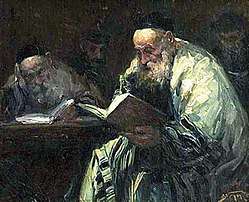Ein Yaakov
Ein Yaakov (Hebrew: עין יעקב) is a compilation of all the Aggadic material in the Talmud together with commentaries. Its introduction contains an account of the history of Talmudic censorship and the term Gemara. It was compiled by Jacob ibn Habib and (after his death) by his son Rabbi Levi ibn Habib.
An English version in 5 volumes appeared in 1921, prepared by Rabbi Shmuel Tzvi Hirsch Glick of Chicago. It presents the original text on the right column of each page, with the corresponding English version to its left. It doesn't include any of the commentaries that appear in the classic version, but Rabbi Glick's translation and accompanying footnotes suffice for comprehension.[1]
Another English translation, by Avraham Yaakov Finkel, titled Ein Yaakov: The Ethical and Inspirational Teachings of the Talmud, was compiled in one volume.[2]
Ayin Ayah
Rabbi Abraham Isaac Kook (commonly known as "Rav Kook," 1865-1935), the first Ashkenazi chief rabbi of British Mandatory Palestine and founder of Yeshiva Mercaz HaRav Kook (The Central Universal Yeshiva), wrote and published a commentary on Ein Yaakov known as Ayin Ayah.[3] In the introduction to the book, Rav Kook writes that he came to write it because of the paucity (in quality and quantity) of "easy to read" Jewish books in his time. The commentary is presented in numbered paragraphs corresponding to the Talmudic text, and it expands upon many diverse subjects in an allegorical style.
The book's introduction is considered significant in its own right. Among other things, Rav Kook presents a historical and philosophical view of the Second Temple period, during which rabbis and Talmudic scholars faced significant persecution from Roman authorities.
History of the Book
Rav Kook began writing the book at the age of 18. It appears that his original intention was to write a comprehensive commentary on all the legends of the Talmud. Completion of the book was delayed for many reasons over the years, however, and as a result, there are significant differences in the style and character of writing throughout it. Much of the book was written during Rav Kook's rabbinical period in Latvia, [4] and the minority after his immigration to the Land of Israel. Rav Kook's writings are extensive, and he is considered one of the most celebrated and influential rabbis of the 20th century. Some rabbis recommend that students of his begin studying his writings with Ayin Ayah.[5]
The print edition of the book comprises four volumes, which speaks to the large amount of content in Ein Yaakov. The manuscript of the book was edited multiple times for publication: once in Eastern Europe and the other in Jaffa (the Jaffa edition was published in full by the Hartzia Institute.) At the end of his life, Rav Kook began to write another edition of the book, which included an interpretation of three pages of the Gemara. This last addition is presented in the new prints at the end of the first and fourth volumes.
Book Name
The source of the name Ayin Ayah ("Eye of Ayah") is found in the verse in the Book of Job (28: 7): "Nativ did not know an eagle and did not pin an eye on Ayah." Ayah is a bird with a sharp vision. The name implies that the author here is paving a new way to study a legend. The name also hints at the name of the author (Ayah evokes HaRaAYaH, the acronym for the rabbi's Hebrew name) and the name of Ein Ya'akov.
References
- ↑ http://www.hebrewbooks.org/9630
- ↑ https://www.amazon.com/Ein-Yaakov-Ethical-Inspirational-Teachings/dp/0765760827
- ↑ Rozenaḳ, Avinoʻam (2007-01-01). "Hidden Diaries and New Discoveries: The Life and Thought of Rabbi A. I. Kook". Shofar: An Interdisciplinary Journal of Jewish Studies. 25 (3): 111. doi:10.1353/sho.2007.0085. ISSN 1534-5165.
- ↑ Letters of Aderet, Igeret 8, Adar Yakar , Jaffa, 1906
- ↑ Rabbi Eliyahu Zaini teaches this book as a preface to the teachings of Rav Kook, and Rabbi Yuval Sherlo, in an appendix to his book Varshtich Lei, recommends the use of Ayin Ayah for the study of Igrot HaRavah.
